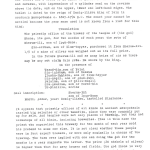Old Babylonian Terracotta Cuneiform Tablet, 1817 BCE - 1794 BCE
Terracotta
1.87 x 3.62
LO.1255
The tablet has a total of 28 lines of Sumerian cuneiform on obverse and reverse, with impressions of the cylinder seal on the reverse above the date, and on the...
The tablet has a total of 28 lines of Sumerian cuneiform on obverse and reverse, with impressions of the cylinder seal on the reverse above the date, and on the upper, lower and left-hand edges. The tablet is dated to the reign of Damiq-ilishu king of Isin in southern Mesopotamia c. 1817-1794 B. C. The exact year cannot be settled because the year name used is not known from a list for this king.
Translation:
The priestly office if the brewer of the temple of (the god) Shana, its god, for two months of each year: the rota of Sherum-ili, son of Ipqu-Nana:
Sin-eribam, son of Ilum-tayyar, purchased it from Sherum-ili. 1/3 of a mina of silver was weighed out as its full price. In the future Sherum-ili and as many heirs of his as there may be may not claim this rota. He swore by the king.
In the presence of Warad-Sin, son of Yala Sin-iqisham, son of Sassu Ilushu-ibbishu, son of Ilum-tayya Sin-nasir, son of Adad-rab Palalum, son of Silli-Ninli Shu-Amurrum, son of Warad-Si Ur-Ninlilla, scrib
Seal inscription:
Sherum-il son of Ipqu-Nan
Month: Addar, year: Damiq-ilishu, installed Ninzianna.
It appears that priestly offices of all kinds in ancient Mesopotamia carried big salaries or other benefits, since they were commonly put up for sale. And temples were not only places of worship, but they had workshops of all kinds, including breweries. Thus in this case the priest who supervised this brewery for two months of each year sold his prebend to someone else. It is not clear whether these people were in fact expert brewers, or were only nominally in charge of the brewing. The turn over implied with one man doing the job for two month in a year suggests the latter. The price (20 shekels of silver) is higher than that for many houses and fields. The god Shana is very little known: only one other mention in a Cassiste period document.
The tablet is in very good condition, with only a few small spots of damage.
Description and translation kindly provided by Professor W. G. Lamber
Translation:
The priestly office if the brewer of the temple of (the god) Shana, its god, for two months of each year: the rota of Sherum-ili, son of Ipqu-Nana:
Sin-eribam, son of Ilum-tayyar, purchased it from Sherum-ili. 1/3 of a mina of silver was weighed out as its full price. In the future Sherum-ili and as many heirs of his as there may be may not claim this rota. He swore by the king.
In the presence of Warad-Sin, son of Yala Sin-iqisham, son of Sassu Ilushu-ibbishu, son of Ilum-tayya Sin-nasir, son of Adad-rab Palalum, son of Silli-Ninli Shu-Amurrum, son of Warad-Si Ur-Ninlilla, scrib
Seal inscription:
Sherum-il son of Ipqu-Nan
Month: Addar, year: Damiq-ilishu, installed Ninzianna.
It appears that priestly offices of all kinds in ancient Mesopotamia carried big salaries or other benefits, since they were commonly put up for sale. And temples were not only places of worship, but they had workshops of all kinds, including breweries. Thus in this case the priest who supervised this brewery for two months of each year sold his prebend to someone else. It is not clear whether these people were in fact expert brewers, or were only nominally in charge of the brewing. The turn over implied with one man doing the job for two month in a year suggests the latter. The price (20 shekels of silver) is higher than that for many houses and fields. The god Shana is very little known: only one other mention in a Cassiste period document.
The tablet is in very good condition, with only a few small spots of damage.
Description and translation kindly provided by Professor W. G. Lamber



